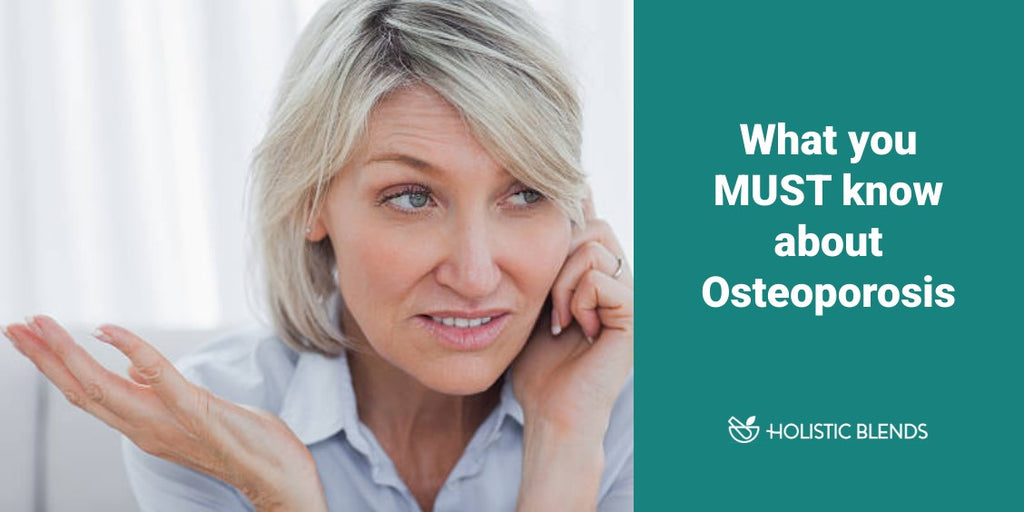According to the International Osteoporosis Foundation, osteoporosis and low bone mass affect approximately 54 million women and men over the age of 50 in the US.
What’s even more unsettling is that 54 million number represents the majority of all people aged 50 and older living in the US! As a result, bone density issues are now considered a “major public health threat.”
What makes osteoporosis tricky is that the disease is usually “silent,” unknowingly developing over many years. For many people, it causes no obvious symptoms or discomfort until eventually—BAM! You experience a bone fracture.
The begging question here is: What’s going on with our bones to have gotten us to the point where bone density issues are now a public health threat?
Well, I have some answers but first let’s look at why osteoporosis is on the rise, even though there’s no shortage of calcium supplements on the store shelves.
Healthy bones—NOT just about calcium
About 20 different nutrients are required to build healthy bones!
Most of the attention is paid to calcium, but there’s more to it than that.
Other nutrients that are needed in the “recipe” for healthy bones include Vitamin D3, magnesium, zinc, manganese, copper, boron, potassium, phosphorus, Vitamin K2, folic acid and protein—but you rarely hear about any of those when osteoporosis comes up.
This explains why our intense focus on calcium hasn’t made a dent in our rates of osteoporosis.
Plus loading up on calcium can ultimately do much more harm than good.
Excess calcium will eventually make its way to the muscles of the heart, the heart valves and the blood vessels, making them rigid and leading to cardiovascular disease!
Vitamin C helps too!
Vitamin C does several things to strengthen your bones.
It helps stimulate bone-forming cells to grow; it helps prevent degradation of bone; it counteracts oxidative stress (which is the force behind aging); and it helps synthesize collagen.
It also works with Vitamins D3 and K2 to direct the calcium that you ingest to where it needs to go—and not in your heart and blood vessels.
Many of us are on an acid trip
Another way we assault our bones is with our diets—specifically eating too many unhealthy acid-forming foods.
Your body is designed to have a slightly alkaline blood pH, and when your pH dips down toward the acid range, it works to counteract that in 2 ways:
First, it expels the acid in your urine and carbon dioxide when you exhale.
If that doesn’t do the trick, your body pulls alkaline minerals out of your muscles and bones to put into the bloodstream in an effort to neutralize the acid.
And the top mineral of choice is: CALCIUM!
So you can take calcium supplements until the cows come home, but if you don’t curb the onslaught of acid in your diet, you’re going nowhere in the fight against osteoporosis.
Drugs are of limited benefit…and pose risks
Osteoporosis drugs like Fosamax or Boniva “work” by slowing bone resorption (breakdown). The less your bones are broken down, the denser they will appear to be.
But that’s only part of the problem with osteoporosis! You also need to encourage healthy bone development too.
Bones that are artificially made denser by drugs are not STRONGER bones, which is the secret the drug manufacturers don’t tell you. In fact, your bones eventually become weaker and more prone to fracture—because osteoporosis drugs do not build any NEW bone.
And like all other drugs in existence, osteoporosis drugs come with a lengthy list of side effects that include elevated cholesterol, joint and muscle pain, arthritis, UTI, pneumonia, indigestion, headaches, loss of strength and dizziness.
What IS the answer to preventing or slowing osteoporosis?
Here are some strategies you can take to the bank in terms of encouraging strong bone health:
1. Have a healthy diet of (mainly alkaline) real foods
By eating a variety of nutritious real foods, you will help increase the likelihood that your body will get all 20 of those nutrients that are needed for healthy bones.
Try to make at least 60 percent of your meals alkaline foods, which are basically fresh fruits and vegetables, and the other 40 percent “good acid” foods like meat, poultry, fish, eggs and dairy.
At the same time, stay far away from “bad acid foods” like processed foods, fast food, refined carbohydrates, coffee and especially soda.
2. Get regular exercise
Regular exercise has been proven to build muscle and bone mass.
It’s never too late—even if you have never exercised in your entire life!
Just get your doctor’s OK, pick an activity you will tolerate (even brisk walking is good!) and get going. Your bones will be very grateful (and so will your waistline, by the way).
3. Supplement with Vitamin D3
Vitamin D3 is crucial to strong bones, but unfortunately, it’s also a VERY common deficiency, and it is my belief that this is a MAJOR factor in our osteoporosis rate.
In addition to striving to get 20 minutes of unprotected sun exposure each day, supplementing with a top-notch product like Optimum DK Formula with FruiteX-B can help ensure you are getting crucial bone-supporting nutrients.
In addition to providing 5,000 IUs of D3, Optimum DK also includes Vitamin K2 and the mineral boron—all of which are bone-supporting superstars!
4. Talk to your doctor about your meds
Taking steroid medications for three or more months has been shown to increase your risk of losing bone mass and developing osteoporosis.
If you are on steroids to treat a disease such as rheumatoid arthritis, asthma, Crohn’s disease, cancer or lupus, then it may be time to have a conversation with your doctor to discuss either reducing your dose or exploring other (safer) options.
Osteoporosis doesn’t have to be part of your future, and even if you’re already experiencing bone loss, you can help turn that around!
Start now.
To your health,
Sherry Brescia











